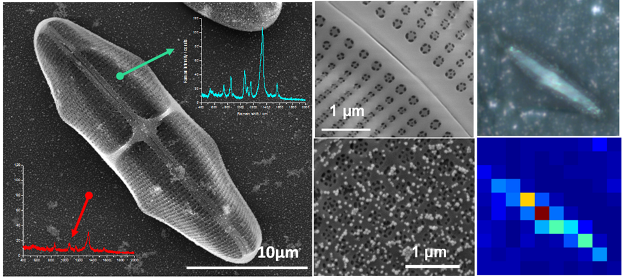
|
Home |
|
Research |
|
Teaching |
|
Publications |
|
Facilities |
|
People |
|
Openings |
|
Group Blog |
|
Research Sponsors: |
|
Surface-Normal Plasmonic Modulator for Three-Dimensional Board-to-Board and Chip-to-Chip Optical Interconnects
|
|
Resonant-Photonic-Device-Enhanced SERS Substrate with Pinpointed Plasmonic-Active Nanotubes
The use of Surface Enhanced Raman Scattering (SERS) for biomolecule detection has been restricted due to the great difficulty of fabricating ultrasensitive and reproducible surface-plasmonic-resonance (SPR) substrates. Therefore, detecting extremely small amount of biomolecules for clinical application is significantly limited. In this STTR Phase II research, we are developing ultrasensitive SERS substrates with universally available Raman "hot spots" for well-reproducible biomolecule detection by combining optical field enhancements from both resonant photonic devices and metallic nanoentities. We use highly robust guided-mode-resonance (GMR) gratings to achieve strongly localized optical field for SERS sensing.
|
|
Current Collaborators: |








|
The objective of this project is to investigate a surface-normal plasmonic modulator with ultra-high energy efficiency and modulation bandwidth for three-dimensional (3-D) optical interconnects using sub-wavelength metallic photonic crystals. The proposed metallic photonic crystal device possesses an asymmetric Fano-resonance that can achieve a sharp transitional edge for energy-efficient electro-optic (E-O) modulation and ultrahigh modulation speed. |

|
Bioenabled Nanophotonic Sensors
The objective of this research is to explore a new type of bioenabled nanophotonic sensors with ultra-high detection sensitivity, specificity, and rapid response time for biomolecule detection. In recent years, rationally designed nanophotonic sensors such as ring resonators, photonic crystals, surface plasmons, and metamaterials have gained tremendous amount of research interests. However, many of these rationally designed nanophotonic sensors reply on cost-prohibitive top-down nanofabrication techniques, which significantly limit the usage for personal diagnostics and point-of-care applications. The proposed research will adopt a bioenabled nanophotonic structure by bottom-up integration of plasmonic (gold or silver) nanoparticles into diatom biosilica. Diatoms are a group of single-celled photosynthetic algae that use biochemical pathways to bio-mineralize and self-assemble amorphous silica structures with exquisite two- and three-dimensional photonic crystal-like structures that can be readily scaled up for large-volume production with low cost. This research will promote in-depth understanding of the truly interdisciplinary bioenabled plasmonic-biosilica nanostructures.
|

|
Near-Infrared Absorption Gas Sensors using Plasmonics-Enhanced Metal-Organic Framework Materials
Low-cost and highly sensitive gas sensors play pivotal roles in many applications. In this program, we developed near-infrared (NIR) absorption gas sensors using plasmonics-enhanced metal-organic framework materials. Two sensor structures, thin-film waveguide and optical fiber based evanescent wave absorption sensors are developed that can be used for in-situ monitoring of CO2 and other gases.
Continuous Manufacturing of Large-area Nanostructured Thin-films via Model-based Design, In-situ Synthesis and Flash-Light Sintering of Nanoparticle Inks
The objective of this proposal is to investigate the fundamental multiscale and multiphysical phenomena underlying a transformational and highly-scalable Nanoparticle-ink (NP-ink) sintering process, i.e., Flash-Light-Sintering (FLS). The new knowledge thus created will guide the creation of novel, scalable processes that combine FLS with equally scalable Microreactor-Assisted Nanoparticle Synthesis (MANS) and Roll-to-Roll (R2R) NP-ink deposition. These advanced processes will possess unmatched capabilities for low-cost, high-throughput, multimaterials capable manufacturing of patterned and continuous thin-films with controlled nanoscale density over large-area flexible substrates. Such thin-films are at the core of devices poised to have a disruptive societal impact, if only scalable manufacturing can be enabled.
|
|
Prof. Thinh Nguyen |